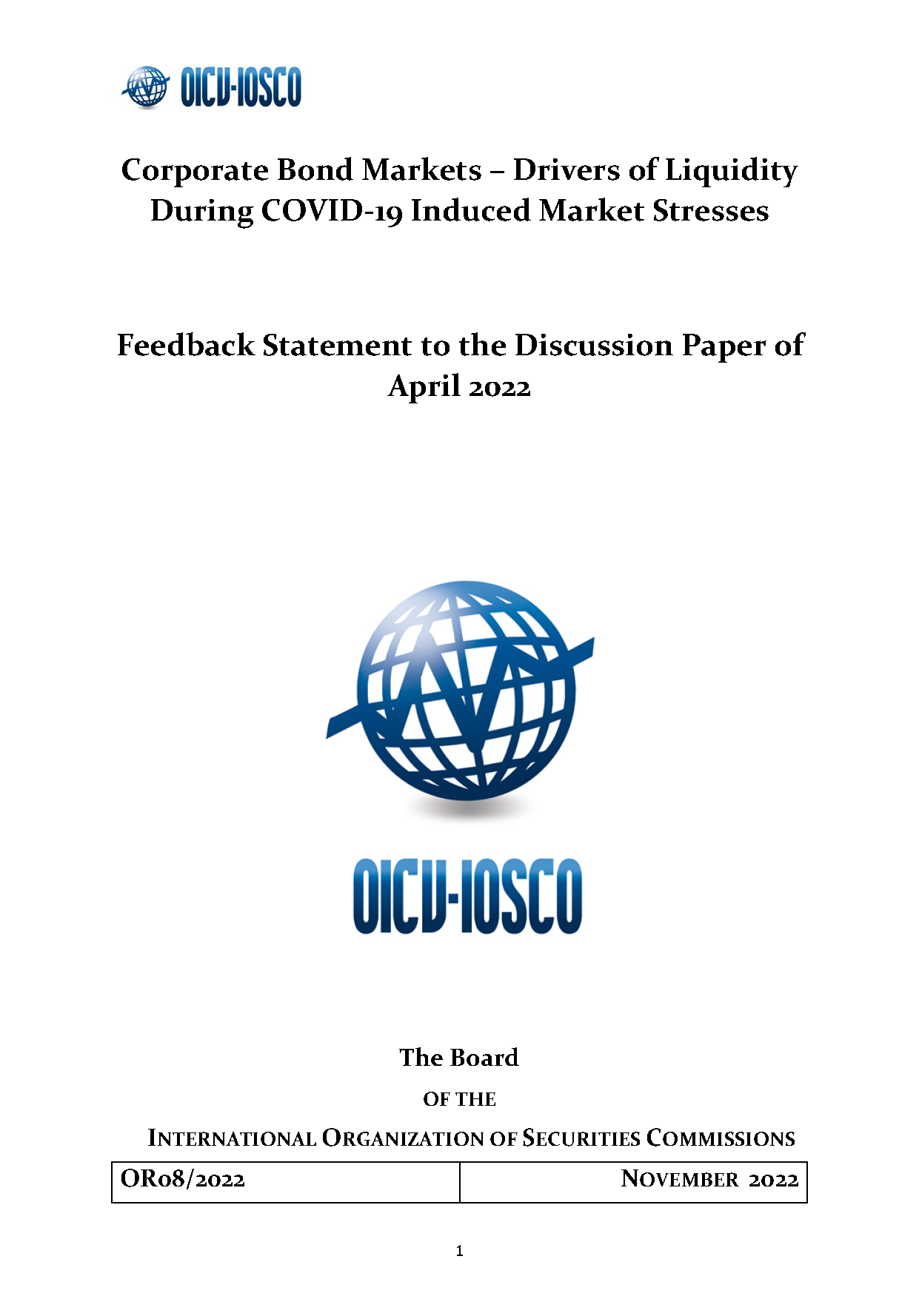
BIX ARTICLE
Feedback Statement to the Discussion Paper of Corporate Bond Markets – Drivers of Liquidity During COVID-19 Induced Market Stresses
Dec 07, 2022
|
4 min read
Featured Posts
Social Bonds Illustrative Use-Of-Proceeds Case Studies Coronavirus
Jul 06, 2020
|
2 min read
Sustainable Banking Network (SBN) Creating Green Bond Markets
Jul 06, 2020
|
2 min read
Why is Inflation Making a Big Comeback After Being Absent for Decades in the U.S.?
Mar 24, 2022
|
7 min read
SC issues Corporate Governance Strategic Priorities 2021-2023
Mar 29, 2022
|
3 min read

This Feedback Statement summarizes the written comments received from stakeholders in response to IOSCO’s published report on corporate bond markets – drivers of liquidity during COVID-19 induced market stresses (the “Discussion Paper”) as well as the outcomes from the joint IOSCO and OECD Conference on Corporate Bond Markets held on 24 June.
Overall summary of feedback received
IOSCO received 15 responses to the Discussion Paper from a variety of respondents, consisting of trade associations, asset managers, exchanges, as well as regulators. Responses were from a mix of geographic regions, but predominantly Europe and the US. Responses also represented a diverse set of perspectives, particularly from trade associations, which represented views across both the buyside and the sellside.
Most of the feedback was framed within each of the 23 discussion questions included in the Discussion Paper. However, some responses consisted of broader, general assessments on the drivers of liquidity for specific regions, specific asset classes, or specific investor types.
In terms of overall feedback, most respondents broadly agreed with the key outcomes of the Discussion Paper, the report’s description of the main features of the corporate bond market as well as the description of market events. In particular, respondents agreed with the observation that the corporate bond market has grown, while dealer intermediation has not kept pace with this growth.
Several respondents, warned against setting policy based on a one-off, tail-end market event such as the COVID-19 market stresses. These respondents noted this type of market event may not be a good representation of market functioning, particularly given the necessity for central bank intervention to stabilize markets. Some others remarked that, in some jurisdictions, the corporate bond market functioned well under the circumstances and may not benefit from reform.
Some respondents remarked that the Discussion Paper did not sufficiently distinguish between the European and the US corporate bond markets, noting that the market function and structure of these markets are substantially different. More specifically, respondents argued that the market turmoil in the US was more extreme than Europe, citing increased trading volumes in the US. Further, that Europe, prior to the COVID-19 market stresses, already had a quantitative easing program in place, though European participants did not benefit from direct access to central bank facilities in the same way that US market participants did.
More generally, it remarked that the European IG corporate bond market, in part due to the central bank’s quantitative easing program, has experienced strong demand for primary issuance with tight spreads for some time, resulting in a difference between the liquidity of primary and secondary markets.
Some respondents remarked that the report would have benefited from a deeper quantitative analysis, particularly for distinguishing between market segments. As noted above, there are inherent data limitations, these include differences in post-trade transparency across jurisdictions and also differences in available information on counterparty type (e.g., dealer, hedge fund/pension fund, insurance company, etc.).
Some respondents suggested additional clarification on the source of the COVID-19 market stresses, particularly that the increase in credit spreads was more extreme than the market stress exhibited through increased bid/ask spreads and that this could be better accounted for.
Some respondents remarked that the Discussion Paper did not have sufficient analysis on the role of both the credit repo and single name credit default swap (SN-CDS) markets which they argue are fundamental (in some regions) in supporting liquidity provision for corporate bond markets. For example, a respondent noted that there was a significant reduction in the depth and breadth of the SN-CDS market, as well as poor liquidity in the credit repo market.
Some respondents noted that the Discussion Paper does did not capture the wider sell-off of all risk assets, the substantial increase in default risk as well as the initial difficulties caused by remote working.
Full Feedback Statement to the Discussion Paper of April 2022: Corporate Bond Markets – Drivers of Liquidity During COVID-19 Induced Market Stresses
Disclaimer
The information provided in this report is of a general nature and has been prepared for information purposes only. It is not intended to constitute research or as advice for any investor. The information in this report is not and should not be construed or considered as an offer, recommendation or solicitation for investments. Investors are advised to make their own independent evaluation of the information contained in this report, consider their own individual investment objectives, financial situation and particular needs and should seek appropriate personalised financial advice from a qualified professional to suit individual circumstances and risk profile.
The information contained in this report is prepared from data believed to be correct and reliable at the time of issuance of this report. While every effort is made to ensure the information is up-to-date and correct, Bond and Sukuk Information Platform Sdn Bhd (“the Company”) does not make any guarantee, representation or warranty, express or implied, as to the adequacy, accuracy, completeness, reliability or fairness of any such information contained in this report and accordingly, neither the Company nor any of its affiliates nor its related persons shall not be liable in any manner whatsoever for any consequences (including but not limited to any direct, indirect or consequential losses, loss of profits and damages) of any reliance thereon or usage thereof.
YOU MAY ALSO LIKE
ARTICLE
Dec 07, 2022
|
4 min read
ARTICLE
Dec 06, 2022
|
4 min read
ARTICLE
Nov 10, 2021
|
13 min read
ARTICLE
Jan 08, 2019
|
6 min read


